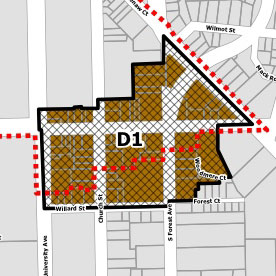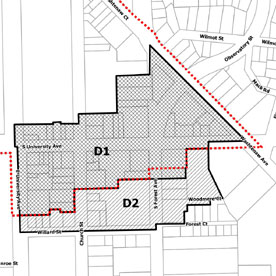What’s Your Downtown Plan?
At its work session Tuesday night, the city of Ann Arbor’s planning commission got a preview of a new floodplain zoning ordinance that Jerry Hancock has been working on with other staff. Hancock is the stormwater and floodplain programs coordinator for the city.
For over an hour, planning commissioners discussed the floodplain ordinance with Hancock before tackling the issue that could result in a near-term flood of communication between city council and planning commission: revisions to the downtown plan. At planning commission’s next meeting on May 19, 2009, commissioners will likely focus on possible revisions to that planning document.
At that May 19 meeting, planning commission will weigh the downtown plan it adopted on Feb. 19, 2009 against the changes that city council made to the commission’s recommended zoning package at council’s April 6, 2009 meeting. And based on the discussion at the commission’s Tuesday work session, it’s not a forgone conclusion that planning commission will revise the downtown plan to accommodate the council’s ordinance changes.
So what’s the big deal, if the downtown plan doesn’t match up with the zoning ordinances? And why doesn’t the city council just amend the downtown plan the same way it amended the proposed zoning ordinances and just “overrule” the planning commission? Otherwise put, why is that planning commission meeting on May 19 going to be worth watching on CTN’s Channel 16 starting at 7 p.m.?
What’s the big deal if the downtown plan doesn’t reflect changes in the proposed zoning ordinance? At Tuesday evening’s work session, Wendy Rampson, with the city’s systems planning unit, put it this way: “Master plans should support the zoning.” It’s not an academic exercise, either. When confronted with a master planning document that’s inconsistent with a zoning ordinance, it’s not clear to developers, or city planners, or councilmembers, which one ought to take precedence.
In the case at hand, the downtown plan and the zoning ordinance package sent to city council by the planning commission were consistent with each other. Changes undertaken to the zoning ordinance package by council made the downtown plan inconsistent in four possible places, which Rampson summarized in a memo to planning commissioners dated May 6, 2009. They’re related principally to two issues: (i) council’s inclusion of an absolute height limit in the core (D1) area of downtown, and (ii) council’s subdivision of the South University area into a core-interface (D1-D2) zone. The second of these “map issues” includes some other areas besides South University: the subdivision by council of the East Huron character area, and the designation as D2 of a specific property [322 E. Kingsley] outside the Downtown Development Authority boundaries.
From Rampson’s memo, the two revisions suggested with respect to the height limit are these [page numbers reference this .pdf file – the version of the downtown plan adopted by planning commission]:
1. Core Areas (page 28) Revise Action Strategy (4) to read: “Incorporate recommended land use and urban design objectives, [including height limits, into] as overlay zoning districts for the review and approval of projects in the Core Areas.”
3. Recommended Zoning Plan (page 52) Revise 1) Downtown Core District, Scale and Massing to read: “Properties in the Downtown Core district should have a minimum height of two stories [and a maximum height of between 14 - 18 stories]. Massing and height requirements for Downtown Core properties should be consistent with the proposed character overlay zoning districts …”
The bracketed material reflects additional language that Rampson has suggested would make the downtown plan consistent with council’s suggested ordinance changes. At the planning commission work session, there was lively discussion on the wording, with chair Bonnie Bona offering the suggestion that the phrase from (1) “including height limits” be changed to “considering height limits.” Commissioner Eric Mahler offered (seemingly in lighthearted fashion) “including the consideration of height limits” as an alternative.
On the wording changes in (3) a consensus seemed to evolve that no reference to height limits was necessary at all. Rampson will draft the language that the commission will consider in its formal deliberations on May 19 – this was just a work session.
Unlike the wording changes, changes to the downtown plan’s maps seem less amenable to compromise solutions:
2. Downtown Planning Zones: Future Land Use Map (Figure 9 on page 30) Revise map to show proposed South University Interface area (see attached map) and 322 E. Kingsley, which Council proposed to be added to the Interface/D2 area.
4. Future Base and Overlay Zoning Plan (Figure 14 on page 55) Revise map to include the proposed South University Interface area, 322 E. Kingsley, and the proposed East Huron 1 and East Huron 2 character areas
As originally adopted by the planning commission, the South University portion of the future land use map looks like this:

Future land use map excerpt: South University Area as adopted by planning commission in February 2009.
And as originally adopted by the planning commission, the South University portion of the future base and overlay zoning map looks like this:

Future base and overlay zoning map excerpt: South University Area as adopted by planning commission in February 2009.
But one of the significant changes made by city council to the zoning proposal was to allow for a D2 (or interface) area inside the South University area. The corresponding map looks something like this (only “something like” because the intent of council was to include the 601 S. Forest development in the D1 section, not the D2 area as shown, because otherwise that building would be non-conforming):

South University area zoning map reflecting changes city council made to the proposed zoning package at its April 6, 2009 meeting.
Both the future land use map and the future base and overlay zoning maps adopted as a part of planning commission’s downtown plan in February are inconsistent with the splitting of the South University area into core (D1) and interface (D2).
At Tuesday’s planning commission work session, commissioner Wendy Woods sought some clarity on what the role of planning commission now was – simply to make the downtown plan conform to council’s revisions? Rampson clarified that with respect to master plans, of which the downtown plan is a part, city council and planning commission have “equal authority.” State law mandates that master plans be adopted by both the planning commission and city council. That is, the typical pattern (with respect to site plans, for example) of planning commission making a recommendation and city council having the final say, does not apply here.
The current timeline for moving the downtown plan and the associated zoning package through to final adoption calls for planning commission to return the downtown plan for action by council at its June 15, 2009 meeting, with consideration of the final vote on the zoning package on July 6, 2009. That would allow the A2D2 oversight committee and city staff to focus on getting design guidelines – which are the final piece of the A2D2 project – done by September 2009.
One possibly scenario is that the downtown plan is repeatedly sent back and forth between planning commission and council with neither body changing its collective mind.
Rampson’s advice to planning commissioners, if they chose not to accommodate the downtown plan to city council’s revisions: “It would behoove you to all sit down in one room!”
If and when city council and planning commission conduct a joint session, it likely won’t be just the South University area that’s discussed. Another revision undertaken by council at its April 6 meeting could be a possible sticking point. That revision entailed the rezoning of 322 E. Kingsley, a property owned by the partners of Zingerman’s Deli, located behind the deli building. Council changed the proposed zoning to D2.
Grace Singleton, one of the managing partners of the deli, explained to the commission during the time allotted for public commentary at Tuesday’s work session, that the goal was to move the operations out of the deli building to the 322 E. Kingsley parcel. The deli building took quite a bit of wear and tear by housing those operations, she said. Speaking at the meeting in support of the rezoning for the Zingerman’s property was John Hilton, editor of The Ann Arbor Observer. Speaking against rezoning (but for the possibility that Zingerman’s could get what it needed through a PUD), was local architect Peter Pollack. Ray Detter, downtown resident and president of the downtown area citizens advisory council, agreed with Pollack.
The property at 322 E. Kingsley is currently zoned R4C. For residents interested in the possibility of a moratorium on construction in R4C areas, that’s another reason to watch the planning commission’s May 19, 2009 meeting on CTN’s Channel 16. At Tuesday’s work session, commissioner Evan Pratt indicated that the meeting would include introduction of language for a proposed recommendation to city council to impose a temporary moratorium in R4C areas.



